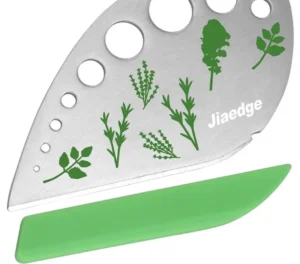The Must-Have Kitchen Tool That Makes Prepping Herbs So Much Easier
There is no comparison between fresh and dried herbs. In raw meals such as salads, dressings, pesto, and garnishes, fresh herbs are indispensable. They have a superior flavor and taste than their dry counterparts. Their main disadvantage is a lack of preparation. Dried herbs are ready to use, but fresh herbs must be washed, stripped, and chopped. Depending on the herb, this process might be highly time-consuming.

If you enjoy utilizing fresh herbs, meet the herb remover, an underutilized tool that can help you prepare them faster.Herb strippers, as the name implies, aid in the removal of leaves from stems. They have varied sized holes to accommodate different herbs. Simply insert the stem into the tiniest hole it will fit into and drag it through until all the leaves fall off. Some strippers have large enough holes to remove kale or other green crops.
Some models may also have a blade, allowing you to strip and chop herbs with the same tool. Others have attached bowls to catch the leaves as they pass through the openings. This technology has the potential to revolutionize the way people cook with fresh herbs. After seeing how rapidly the stripper works, they may be inspired to use herbs more frequently. It may even inspire home chefs to try different herbs for the first time. So here are some pointers to keep in mind.
herb stripping bowl
To begin, immediately wash and dry any fresh herbs you purchase to remove any pests or dirt. Wrap the herbs in paper towels and place them in sealable bags. The paper towels will help keep the herbs fresh, but use them within a few days to get the most flavor out of them. Fortunately, there are numerous ways to appreciate their distinct tastes. Basil is one of the most popular herbs, possibly because of its sweet and somewhat spicy flavor. It is widely used in Mediterranean recipes, but it can also be used in other cuisines.

Not to mention that it’s the most commonly used herb in pesto. If you want to get the most out of your basil, add the leaves (not the stems) near the end of the cooking process, whether you’re making fish, chicken, or a homemade pasta sauce. Rosemary is a difficult plant to prepare, making it ideal for the herb remover. However, the leaves have a fantastic woody and pine-like flavor. This makes it ideal for dishes such as lamb chops, poultry, roast beef, and roasted potatoes. It’s also great on flatbread, sweet potato fries, and even cake.
Cilantro, often known as the coriander leaf, is a contentious herb. Some individuals enjoy the bright and zesty flavor, while others claim that it tastes like soap. However, it is a common ingredient in Asian and Latin American cuisine. Cilantro is wonderful both raw and cooked, and it is flavorful without being overbearing. Dill – Dill is a frequent ingredient in German and Scandinavian cuisine. It has a delicate flavor that is robust, fresh, and earthy. It goes well with a variety of cuisines, including poultry, yogurt, shellfish, salad, soup, and egg dishes such as quiche.

Marjoram – Marjoram has a softer flavor than oregano but is nonetheless potent. It goes well with vegetables and meat, but it can also be used to flavor salads, soups, sauces, fish, and other dishes. While the leaves are used in these dishes, keep the stems to enhance the flavor of a stock or soup. Thyme – Thyme can be found in French cuisine. Its floral scent and powerful flavor complement foods without overpowering other ingredients. A herb remover, like rosemary, can make thyme preparation a breeze. It goes well with roast chicken, bread, potatoes, and cocktails.
Mint – While many people associate mint with drinks and pastries, there are plenty other ways to enjoy this herb. It goes well with salads, poultry, curries, and sandwiches. It can also be used to dress up a fruit salad. Parsley – Because of its fresh and delicate flavor, parsley is another useful and popular herb. While the leaves are the most effective, the stems can also be used in cooking. Use it as a garnish to season soups or to dress up salads. The possibilities are nearly limitless, but parsley pairs particularly well with pasta, butter, eggs, and lemon.
Oregano has a strong taste that is necessary in recipes such as chili pasta and pizza sauces. Unlike herbs like basil, oregano can resist heat, so use it at the start of the cooking process. However, use oregano sparingly so that it does not overpower the other ingredients. Save the stems to flavor stocks and soups.



